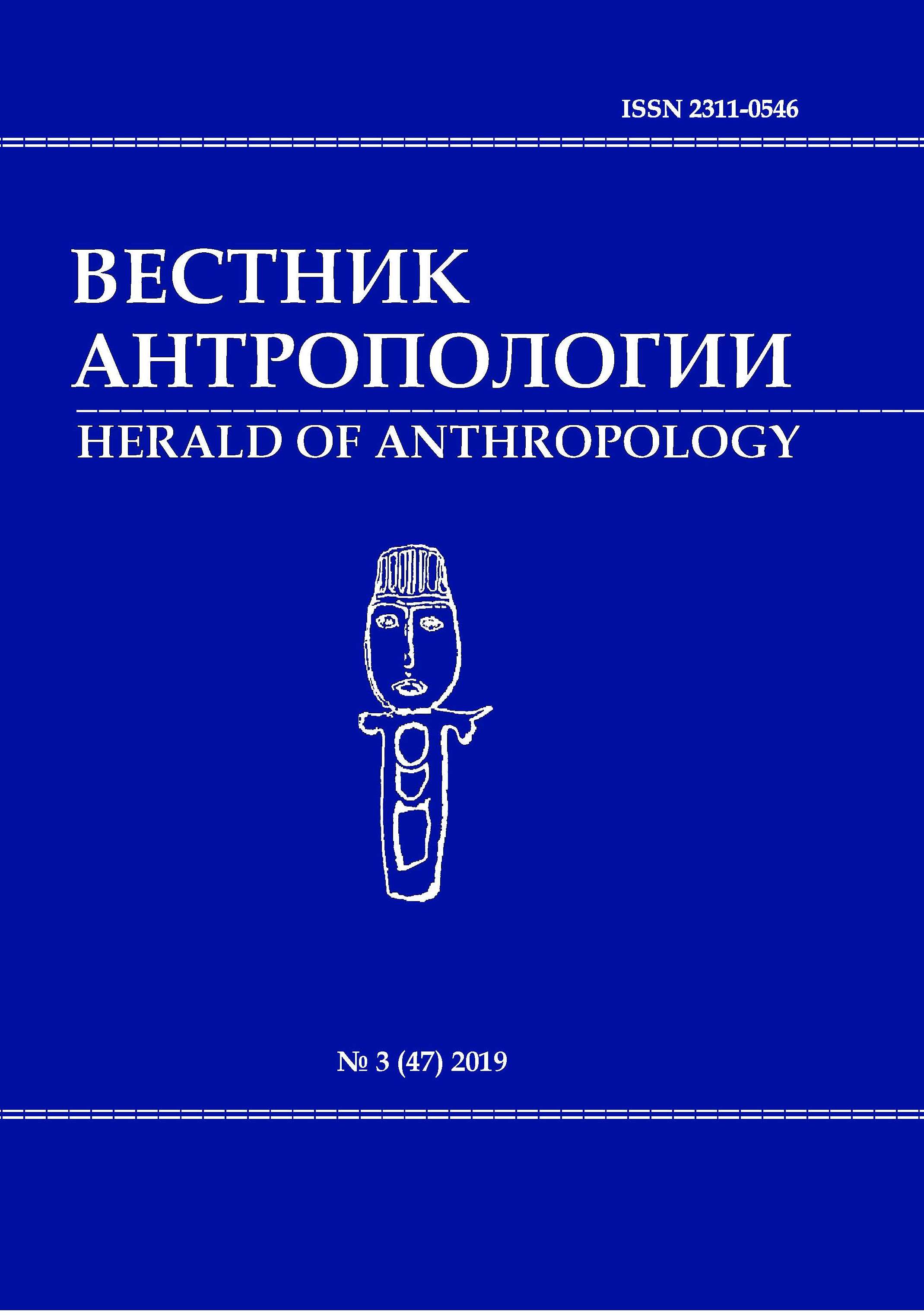Craniological Study of Population of Pereslavl-Zalesskiy in the XVI–XVIII Centuries
DOI: 10.33876/2311-0546/2019-47-3/72-89
Keywords:
physical anthropology, craniology, urban population, Russians, XVI–XVIII centuries, Pereslavl-ZalesskyAbstract
The study is based on intra and inter-group analyses of craniometrical characteristics of two samples of skulls obtained during the excavations of urban cemeteries in modern Pereslavl-Zalesskiy. The samples under study consist of 29 male and 19 female skulls from necropolis of the Church of the Beheading of John the Baptist XVI – early XVII centuries and 31 male and 26 female skulls from Andrey Smolensky Church cemetery XVI–XVIII centuries. To identify differences between the samples from Pereslavl-Zalesskiy we used Student's t-test. The principal component method and the canonical variate analysis were used for the intragroup and intergroup analyses respectively. Intragroup analysis revealed certain heterogeneity of these groups. The male samples from Pereslavl were demonstrated to be significantly different. This probably indicates a partial replacement of population that occurred after the tragic events of the Time of Troubles, which virtually devastated the city’s neighborhood at the beginning of the XVII century. The results of the intergroup canonical analysis demonstrated the greatest proximity of the Pereslavl’s group XVI–XVII centuries to the samples from Pskov and Suzdal. The proximity of the later samples from Pereslavl-Zalessky to the groups of Moscow and Tver may indicate that the population of these cities made a significant contribution to the formation of the Pereslavl-Zalessky’s population after the Time of Troubles. Female samples from Pereslavl significantly differ among themselves in a number of metric cranial traits. The results of intergroup canonical analysis demonstrate the greatest proximity of the female samples from Pereslavl to each other, and to the samples from Pskov, Tver and Moscow, like in the male samples.
References
- Alekseev, V.P., and G.F. Debets. 1964. Kraniometriia. Metodika antropologicheskikh issledovanii [Craniometry. Methodology of anthropological research]. Moscow: Nauka.
- Alekseev V.P. 1966. Osteometriia. Metodika antropologicheskikh issledovanii [Osteometry. Methods of anthropological research]. Moscow: Nauka.
- Alekseev, V.P. 1969. Proiskhozhdenie narodov Vostochnoi Evropy (kraniologicheskoe issledovanie) [Origin of the peoples of Eastern Europe (craniological study)]. Moscow: Nauka.
- Alekseyeva, T.I. 1973. Etnogenez vostochnykh slavyan po dannym antropologii [Ethnogenesis of the Eastern Slavs according to anthropology]. Moscow: MGU.
- Alekseyeva, T.I. 2002. Antropologicheskaya kharakteristika vostochnykh slavyan epokhi Srednevekov’ya v sravnitel’nom osveshchenii [Anthropological characteristics of the Eastern Slavs of the Middle Ages in comparative coverage] / T.I. Alekseyeva. Vostochnyye slavyane. Antropologiya i etnicheskaya istoriya. edited by T.I. Alekseyeva, 160-170. Moscow: Nauchnyy mir.
- Veselovskaya, Ye.V., O.M Grigor’yeva, A.P. Pestryakov, and A.V. Rasskazova. 2015. Antropologicheskaya izmenchivost’ naseleniya Vostochnoy i Tsentral’noy Yevropy ot srednevekov’ya do sovremennosti [Anthropological variability of the population of Eastern Europe from the middle ages to modern times]. Vestnik Moskovskogo universiteta. Seriya XXIII. Antropologiya 1: 4-24.
- Goncharova, N.N. 2011. Formirovaniye antropologicheskogo raznoobraziya srednevekovykh gorodov: Yaroslavl’, Dmitrov, Kolomna [Formation of the anthropological diversity of medieval cities: Yaroslavl, Dmitrov, Kolomna ]. Vestnik antropologii 19: 202-216.
- Goncharov, I.A., and N.N. Goncharova. 2016. Programma MultiCan dlya analiza mnogomernykh massivov dannykh s ispol’zovaniyem statistik vyborok i parametrov general’noy sovokupnosti (MultiCan) [MultiCan program for analyzing multidimensional data sets using sampling statistics and parameters of the general population (MultiCan)] // Svidetel’stvo o gosudarstvennoy registratsii programmy dlya EVM №2016610803.
- Dubov, A.I., and N.A. Dubova. 2000. Antropologicheskaya kharakteristika chetyrekh kraniologicheskikh seriy s territorii Moskvy [Anthropological characteristics of the four craniological series from the territory of Moscow]. Narody Rossii: ot proshlogo k nastoyashchemu. Antropologiya Pt .2, edited by T.I. Alekseyeva, 130-150. . Moscow: Staryi sad.
- Zeyfer, V.A., O.I. Mazurok, and A.V. Rasskazova. 2014. Srednevekovyy nekropol’ tserkvi Useknoveniya glavy Ioanna Predtechi v Pereslavle – Zalesskom [Medieval necropolis of the Church of the Beheading of John the Baptist in Pereslavl-Zalessky]. Arkheologiya Podmoskov’ya 10: 304–321.
- Zeyfer, V. A., O.I. Mazurok, and A.V. Rasskazova. 2016. Srednevekovyy nekropol’ v yugo-vostochnoy chasti kremlya Pereslavlya-Zalesskogo [Medieval necropolis of the Church of the Beheading of John the Baptist in Pereslavl-Zalessky]// Arkheologiya Podmoskov’ya 12: 342–350.
- Moiseyev, V.G., V.I. Khartanovich, and I.G. Shirobokov. 2012. Kraniologiya pozdnesrednevekovogo naseleniya Vologdy [Craniology of the Late Middle Ages population of Vologda]. Vestnik MGU. Seriya XXIII. Antropologiya 3: 95-109.
- Pezhemskiy, D.V. 2000. Novyye materialy po kraniologii pozdnesrednevekovykh novgorodtsev [New materials on craniology of late medieval Novgorod Narody Rossii: ot proshlogo k nastoyashchemu. Antropologiya Pt .2, edited by T.I. Alekseyeva, 95-129. . Moscow: Staryi sad.
- Rasskazova, A. V., G. A. Pozdeyev, and N. Ya. Berezina. 2016. Paleoantropologiya goroda Pereslavl’-Zalesskiy po materialam raskopok 2013 goda [Paleoanthropology of the city of Pereslavl-Zalessky based on the materials of the excavations of 2013]. Arkheologiya Podmoskov’ya 12: 351–362.
- Smirnov, M.I. 2004. Doklady Pereslavl’-Zalesskogo Nauchno-Prosvetitel’nogo Obshchestva [Reports of Pereslavl-Zalessky Scientific-Educational Society]. Moscow: MelanarO.
- Sankina, S.L. 2000. Antropologicheskiy sostav srednevekovogo naseleniya Novgorodskoy zemli [Anthropological characteristics of the medieval population of the Novgorod land Narody Rossii: ot proshlogo k nastoyashchemu. Antropologiya Pt .2, edited by T.I. Alekseyeva, 5-66. Moscow: Staryi sad.
- Spiridov, A.A. 1907. Velikorussy Pereyaslavskogo u., Vladimirskoy gub. [Velikorussy from Pereyaslavsky District, Vladimir’s Province] Russkiy antropologicheskiy zhurnal 15-16: 137–145.
- Sukina, L.B. 2002. Pereslavl’–Zalesskiy [Pereslavl – Zalessky]. Moscow: Slavprint.
- Kharlamova, N.V. 2012. Tverskoye naseleniye XVI–XX vekov po dannym kraniologii [Tver populationof the XVI-XX centuries according to craniology]. Vestnik antropologii 21: 49-58.
- Ekzemplyarskiy, A. V. 1891. Velikiye i udel’nyye knyaz’ya Severnoy Rusi v tatarskiy period, s 1238 po 1505 g.[ The Great and Appropriated Princes of Northern Russia in the Tatar Period, from 1238 to 1505]. 2. Vladetel’nyye knyaz’ya Vladimirskikh i Moskovskikh udelov i velikiye i udel’nyye vladetel’nyye knyaz’ya Suzdal’sko-Nizhegorodskiye, Tverskiye i Ryazanskiye. St. Petersburg: Tipografiya Imperatorskoy Akademii nauk.





















